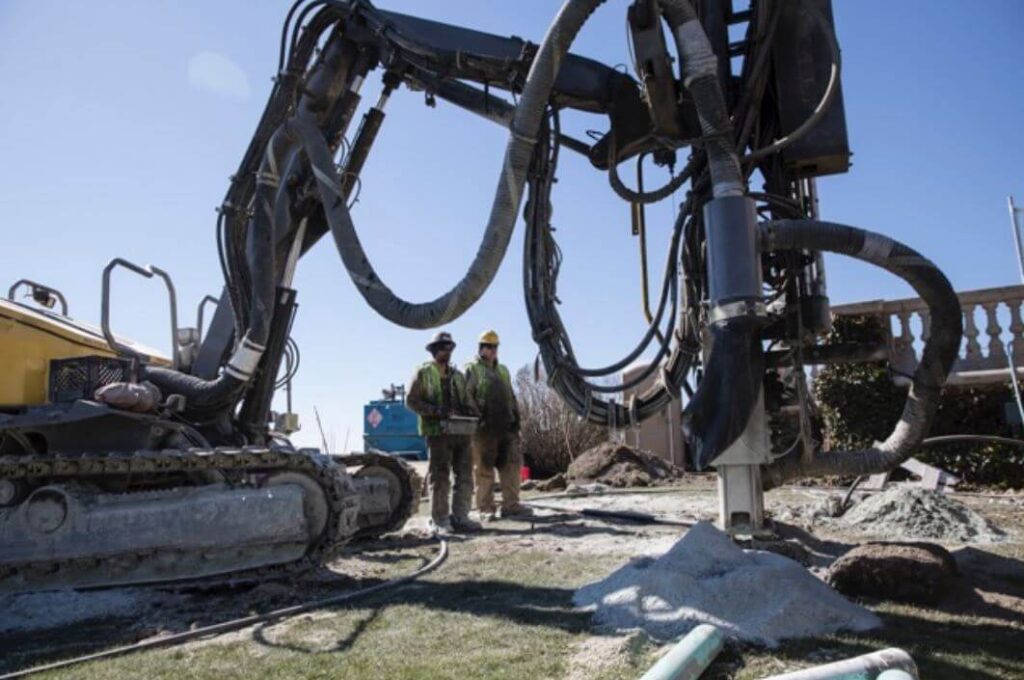Even in old buildings, new technologies can be extremely beneficial. One relatively new HVAC technology that is becoming more popular each year is called “Ground source geothermal heat pump.” Rather than drawing its heat from either electricity or a fuel source, it uses the natural latent heat contained in the ground below a building to provide heat in the winter and to absorb heat in the summer. The “borrowing” of this energy allows these systems to outperform all others in efficiency regularly achieving 120% efficiency based on the energy needed to circulate the coolant.
As a result of this extreme level of efficiency it is becoming possible to use geothermal heat pumps to heat and cool spaces that would have been prohibitively expensive to do otherwise. One instance is the recent addition of this system to heat and cool the Breakers, designed in 1892 by Richard Morris Hunt for Cornelius Vanderbilt II. This 125,000 square foot structure was built as a “summer cottage” to be used only 8-10 weeks per year in the summertime before the time that air conditioning had been invented. Although a heating system was part of the original construction, issues of humidity control and the expense of managing the heating bill were not concerns at the time of its original use.

The opportunity to save 70% on heating costs and the similar benefit to the environment were no doubt strong reasons to apply this new technology to the age-old problem of heating, cooling and conditioning the air in such a large and voluminous building. Additionally, the fluctuations in humidity were beginning to have a detrimental impact to both the building and the precious period furnishings of the house.
For traditional homeowners the desire to save money down the road and to help greatly reduce their contribution to the release of “greenhouse” gases is counterweighted by the higher upfront cost of geothermal compared with conventional systems. The key to decision-making usually involves the calculation of payback time of the geothermal cost differential or the ROI (Return Of Investment), based on current or forecasted electricity, oil or gas prices. But with low interest rates the relative value of future savings increases greatly.
Of additional benefit is the fact that the heat transfer medium is food-quality glycol as opposed to the potentially poisonous and very environmentally destructive freon that is used in conventional systems. Traditional air conditioning systems pump additional heat into the summer air through exterior condensers. In cities where there are thousands and even millions of traditional air conditioners this can increase the ambient temperature of the outside air to a considerable degree worsening the exterior condition. From a purely thermodynamic standpoint pushing heat into air that is already hot is difficult and inefficient, whereas with a geothermal heat pump the temperature of the ground and groundwater is constant at about 55 degrees year-round. This make the ground an ideal source of heat in the winter and ideal heat sink in the summer with the two cycles offsetting one another to keep the system in long-term balance.
To learn more about how this new technology has been applied to the Gilded Age building there will be a public online presentation on September 24 at 5:30pm entitled “The Breakers Geothermal System: a Twenty-first Century Solution” as part of the Preservation Society of Newport County’s fall lecture series. The presentation will be given by Patricia Miller, Chief Conservator of the PSNC. To register for the presentation, write “Geothermal Lecture” in the subject line and send an email to ProgramRSVP@NewportMansions.org.
Click on the link below to watch a quick video about the geothermal installation in the Breakers: https://www.youtube.com/watch?time_continue=119&v=72YoyQJgFng&feature=emb_logo
Looking to remodel your home? Let’s connect.
Join the Architectural Forum to stay up-to-date with architectural news from Rhode Island and abroad.
Ross Sinclair Cann is an author, educator and practicing architect. He holds honors architectural degrees from Yale, Cambridge and Columbia Universities and is Founding Principal at A4 Architecture in Newport Rhode Island. He has designed for the installation of geothermal heat pumps at many of his residential, commercial and institutional projects.

Brilliant natural alternative source!
I’m interested to see costs of installation.
Lawrence Air of Sekonk, MA did the installation but do residential sized systems as well!
On what scale of housing is this system feasible? Is less area less, or more, expensive to install? Sounds so ideal, for pocket & globe ….
The systems get less expensive per heating and cooling units as they get larger. One up front expense is drilling a well (or wells) to access the heat sink under the building which is similar in cost regardless of capacity.